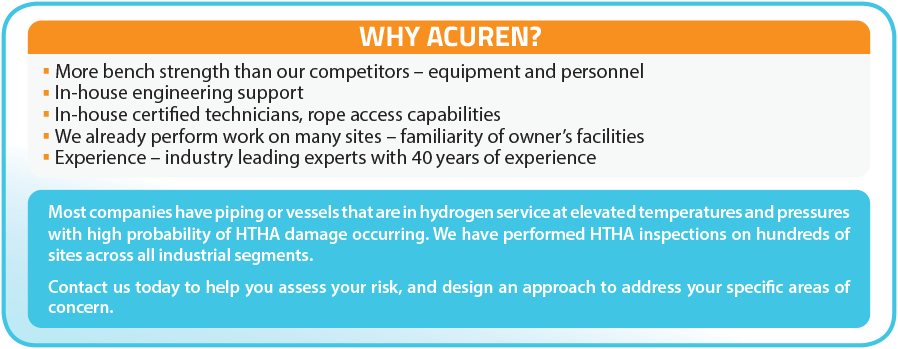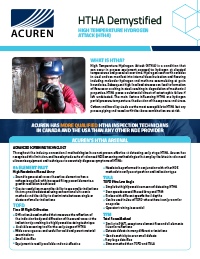- About
- About Overview
- Vision & Values
- Leadership Teams
- Corporate
- Canadian Operations
- United States Operations
- Service Line
- AcuCares Foundation
- Safety
- Quality
- Environment
- Sustainability
- Indigenous Policy
- Hellier Training
- Applied Inspection
- Engineering
- Engineering Overview
- Field Engineering
- Field Engineering Overview
- Ferrite Testing
- Hardness Testing
- Metallurgical Replicas
- Optical Emission Spectroscopy (OES)
- Positive Material Identification (PMI)
- Materials Testing & Analysis
- Materials Engineering
- Metallurgical Condition Assessment
- Steam Cycle Chemistry Services
- STRAP – Steam Turbine Risk Assessment Program
- Support for Industrial Insurers and Independent Adjusters
- Water Treatment Technologies Services
- Reliability Engineering
- Vibration Analysis
- Inspection
- Inspection Overview
- Advanced NDE/NDT
- Moisture Detection Imaging (MDI)
- Non-Intrusive/On Stream Inspection Program
- Phased Array Services
- Time of Flight Diffraction Technique (ToFD)
- Tube to Tube Sheet Weld Inspection
- NDE/NDT
- Visual Inspection (VT)
- National Board Program
- Drone & Robotic Inspection Services
- Lab Services – Inspection & NDT
- Rope Access for Inspection
- Inspection Training
- Rope Access Industrial Services
- Solutions
- Access Planner
- Ammonia Systems Inspection Services
- Asset Integrity Management / Mechanical Integrity
- Cathodic Protection Services
- Corrosion Under Insulation
- Drone & Robotic Inspection Services
- Facilities Piping Management Programs
- High Energy Piping Programs & Solutions
- Hydrogen Industry
- Laboratory Services – Inspection and NDT
- Laboratory Services – Materials Testing & Analysis
- Midstream Integrated Integrity Solutions
- National Board Program
- Non-Intrusive/On Stream Inspection Program
- PHMSA Mega Rule Solutions
- Research and Application Development
- Rope Access for CUPS
- Industries
- Sound is generated across the active elements when a voltage is applied, with increased firing power/elements, a greater resolution is achieved
- Greater resolution means the ability to see smaller indications that may not be detected using conventional ultrasonic methods and the ability to discriminate between single or clusters of smaller indications
- Diffraction-based method that measures the reflection of the indication body and diffraction of the sound wave at the indication tips making it a highly sensitive sizing technique
- A reliable screening tool for the early stages of HTHA
- Wide coverage area and useful for weld and parent material examinations
- Small data files
- Equipment is readily available and cost effective
- Needs to be performed in conjunction with other NDE methods to verify exact position and indication type
- Simple but highly sensitive means of detecting HTHA
- Scan speeds exceed Phased Array and TFM
- Probes with different specific focal depths
- Can be used in-lieu of TOFD where there is only room for one probe
- Operator training is essential
- Similar to PAUT, except one element fires and all elements listen for reflections
- Detects defects in many different orientations
- Good sensitivity to even small defects
- Very large data files
- Slower method than TOFD and TULA
HTHA DemystifiedJune 28, 2019What is HTHA?
High Temperature Hydrogen Attack (HTHA) is a condition that can occur in process equipment exposed to hydrogen at elevated temperatures and pressures over time. Hydrogen reacts with carbides in steel and can manifest into internal decarburization and fissuring including molecular hydrogen and methane accumulating at grain boundaries. Subsequent high localized stresses can lead to formation of fissures or cracking in steel, resulting in degradation of mechanical properties. HTHA poses a substantial threat of catastrophic failure if left undetected. The main factors influencing HTHA are hydrogen partial pressure, temperature, the duration of the exposure, and stress.
Carbon and low alloy steels are the most susceptible to HTHA but any process piping and vessels with the above combination are at risk.

Acuren’s HTHA Arsenal
Throughout the industry, conventional methodologies have not proven effective at detecting early stage HTHA. Acuren has recognized this limitation, and has adopted a suite of advanced NDE screening methodologies that employ the latest in advanced ultrasonic equipment and techniques to accurately diagnose symptoms of HTHA:
64 Element PAUT – High Resolution Phased Array
TOFD – Time of Flight Diffraction

TULA – TOFD Ultra Low Angle
TFM – Total Focus Method
Because HTHA inspections aren’t regulated, Acuren’s combination of engineers, specialists and rope access experts can help take the guesswork out of your approach, assist you with designing a program that fits your specific equipment, and minimize your risk profile

In-House Engineering
Our in-house engineers can utilize the findings of the advanced NDE technologies in conjunction with Fit For Service (FFS) API 579 engineering evaluations to determine the best course of action for your assets. If early stage HTHA is suspected, the FFS can quickly resolve if the asset can continue to run, or determine correct inspection methods and intervals for mitigation of risk.
HTHA Specialists
ACUREN HAS MORE QUALIFIED HTHA INSPECTION TECHNICIANS IN CANADA AND THE USA THAN ANY OTHER NDE PROVIDER
The evaluation of HTHA damage is highly specialized and requires advanced HTHA training which may include 3rd party training or performance demonstration qualification examination recognized by owner/users. Acuren has more qualified HTHA inspection technicians in Canada and the US than any other NDE provider, a number of whom also hold rope access qualifications. We have the resources (personnel & equipment) to support customers across North America.
Email us or call 1-800-218-7450 today to help you assess your risk, and design an approach to address your specific areas of concern.
Our ServicesEngineeringAcuren’s world-class teams of over 100 engineers have extensive experience both in the field and in our laboratories to provide a higher level of reliability.InspectionAcuren offers you an unrivaled spectrum of traditional and advanced nondestructive testing and NDE methods to ensure cost-effective and accurate inspection results.Rope Access Industrial ServicesAcuren provides integrated industrial services including inspection, repair and maintenance via rope access using composite crews with multi-disciplined trades, experienced personnel, IRATA certified technicians, and customized access optimization programs.Success StoriesMonthly Maintenance Contract Pays DividendsEach month Acuren Condition Based Monitoring Specialists collect machinery vibration and structure borne ultrasonic data as part of the regular condition monitoring program at Irving Wallboard.
Ropes Team Saves Thousands on Pump Box WorkDuring a planned outage ultrasonic testing and visual inspection revealed that a significant portion of the pump box floor either needed to be repaired, or cut out and replaced.
Related IndustriesAerospaceAcuren has a specialized team with aerospace industry experience that use both traditional and advanced nondestructive testing methods to identify defects in critical structural, airframe, and engine and accessory components.MiningAcuren’s engineering, inspection and industrial services teams consist of engineers, technologists and tradespeople with a diverse educational background, working in the mining industry for over 40 years.RailWe are familiar with the unique codes and regulations of the rail industry, including DOT in the US and Transport Canada, and we're constantly innovating to create enhanced testing procedures that ensure optimum quality and safety.

